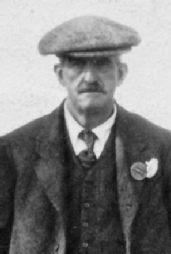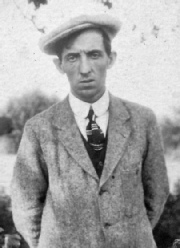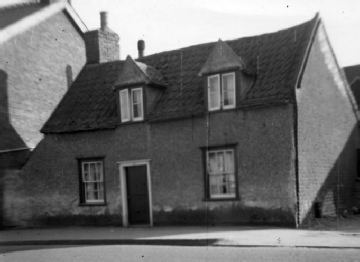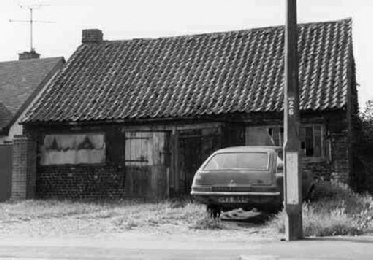
The Village Blacksmiths
Reproduced by Richard Kirton on 21st April 2012 from
Phyllis Alp’s original late 1960s account of her father’s business.
The first date recorded of a member of the Alp family being blacksmiths in Gt. Wakering is 1851. James Alp known as John came to Wakering to set up in business after serving an apprenticeship at Rochford.
The original forge where John worked, was the building at 127 High St, now the cycle shop. Horse shoes were all hand-made and much of this work was done on the farms, where he would go by horse and cart, with a mate to cold shoe the horses. Some 300 horses were on Potton Island in his day, which he kept shod for 2/6 per horse per year.
John and his wife Eliza had six daughters and two sons, the eldest son George was my grandfather. He was born in 1868.
Apart from shoeing and repairing farm implements, other iron work was done as the Brickfields were becoming a thriving industry in Gt. Wakering.
The old forge became too small to cope with the increased trade and by this time George was old enough to be helpful in the business. A new forge was built, the one that stands today. Bricks for this were brought from the brickfields at Landwick in cart loads when their horses came to be shod. Even in those days there were wage problems, one man agreed to lay bricks at 6d per hour another offered to do it for 4d.
In 1889 tragedy came to the family. John’s wife aged 53, his daughter Rose aged 10yrs and son William aged 19 all died of typhoid fever between Oct. 9th and Nov. 23rd. Soon after this George took over the business. He was not a very good scholar, but his wife Mary was a great asset to him. With her beautiful handwriting and head for figures she did the book keeping for him.
Bills were only sent out quarterly and many of his customers were slow to settle their accounts. One such gentleman in the village had a long outstanding account so George decided to call on the debtor. A servant came to the door, George was asked in, after saying that he would like to see Mr So & So. The maid returned with the message, that her master was too busy to see anyone. Grandad would not be put off and said “Go and tell Mr So & So that I have plenty of time and have brought my supper with me.
The cost of shoeing a horse all round at this time was 2/6 for a pony and 3/- for a farm horse, all shoes were hand-made.
My father Wilfred started to work in the forge as soon as he could lift a hammer, all the jobs done during the day were recorded by him, on a slate in the shop which Grandma used to copy into the account book.
Much work was done for the Brickfields some things made were dogs @ 8d doz, bytes 4d each and C links 4d each. Barge anchors and irons were repaired for the numerous barges which came into Millhead.
In 1914 John died. During the war George served as a special constable and my father served in the Royal Engineers as a Farrier.
Grandad was a keen gardener and won many prizes at the horticultural shows in the 1920s.
With the coming of the motor car horses were not used so much, but the cost of shoeing rose with the price of iron. Most shoes could be bought ready made in various sizes and be adapted to fit the horse. The charge for a full set at this time was 8/-. The work of fitting then took 1 hr.
With the decreasing trade the cycle shop was opened as a side-line in which my father took great interest.
My Grandma died in 1937 and Grandad in 1941. During the 2nd World War my father served as a special constable keeping up the family tradition.
Much work was still done for the Brickfields and surrounding farms, many jobs he tackled were very remote from that of a blacksmith once he made a hat stretcher, and on another occasion he made a telescopic toasting fork, so that one of the local farmers could make toast without burning his fingers. When he gave up shoeing the price of a set of shoes was 18/-.
Only a few weeks ago a man called to see if my father would show him how to shoe a horse as he thought that £3 was rather a lot to pay for a set of shoes.
Children used to go into the forge to blow the fire, and some learned the hard way that the glowing iron did not become cold when it became black
Many used to gather round the door of the smithy, to see the sparks flying from the anvil, as the red hot iron was being struck by a heavy hammer. How they enjoyed seeing the horses shod and many a time they scattered when one of the animals refused to stand still. The pungent smell of burning hoof did not deter them, and today the memory of this smell lingers in the nostrils of childhood visitors.
Those days have passed, no longer does the smoke pour through the wide door way, but still the children come to see the Village Blacksmith as he stands by his gate next to the forge.




George James Alp in 1920
Wilfred George Alp in 1920
Wilf Alp’s Cottage 1960
Wilf Alp’s Old Forge 1984
Wilf Alp’s house being demolished in 1961 with the replacement bungalow already built behind it. Cripps the Bakers is seen to the left of the demolished house.
Wilf Alp’s Bike Shop, High Street, Great Wakering between 1961 and 1974. Wilf Alp is standing at his gate. Cripps the Baker is seen on the left and Alps Bike Shop on the right.



© 2015 - Richard Kirton - All Rights Reserved | Privacy Policy | Terms of Use | Site Map

